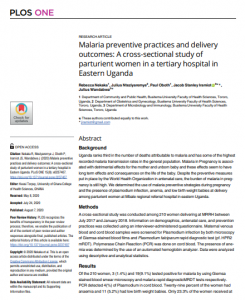
Background
Uganda ranks third in the number of deaths attributable to malaria and has some of the highest recorded malaria transmission rates in the general population. Malaria in Pregnancy is associated with detrimental effects for the mother and unborn baby and these effects seem to have long term effects and consequences on the life of the baby. Despite the preventive measures put in place by the World Health Organization in antenatal care, the burden of malaria in pregnancy is still high. Researchers determined the use of malaria preventive strategies during pregnancy and the presence of plasmodium infection, anemia, and low birth weight babies at delivery among parturient women at Mbale regional referral hospital in eastern Uganda.
Methods
A cross-sectional study was conducted among 210 women delivering at MRRH between July 2017 and January 2018. Information on demographics, antenatal care, and prevention practices was collected using an interviewer-administered questionnaire. Maternal venous blood and cord blood samples were screened for Plasmodium infection by both microscopy of Giemsa-stained blood films and Plasmodium falciparum rapid diagnostic test (pf. HPR2 mRDT). Polymerase Chain Reaction (PCR) was done on cord blood. The presence of anemia was determined by the use of an automated hemoglobin analyzer. Data were analyzed using descriptive and analytical statistics.
Results
Of the 210 women, 3 (1.4%) and 19(9.1%) tested positive for malaria by using Giemsa stained blood smear microscopy and malaria rapid diagnosticMRDT tests respectively. PCR detected 4(%) of Plasmodium in cord blood. Twenty-nine percent of the women had anaemia and 11 (5.2%) had low birth weight babies. Only 23.3% of the women received at least three doses of IPTp-SP and 57.9% reported sleeping under an Insecticide Treated Net the night before the survey. The women who reported sleeping under a mosquito net the previous night (OR 0.67, 95% CI: 0.24–1.86) and those who reported taking fansidar as a directly observed therapy (OR 0.31, 95% CI: 0.04–2.39) appeared to have few chances of getting plasmodium infection though the findings were not statistically significant.